ShodhKosh: Journal of Visual and Performing ArtsISSN (Online): 2582-7472
|
|
DESIGN FOR SUSTAINABILITY USING A CRAFT-BASED HUMAN-CENTRIC APPROACH AND CONSUMER PARTICIPATION
Dr. Anupam Saxena 1![]()
![]() ,
Shalini Pandey 2
,
Shalini Pandey 2![]()
![]()
1 Associate
Professor, Textile Design National Institute of Fashion Technology, Bhopal,
India
2 Freelance
Designer and Consultant, Former Project head CRISP, Bhopal, India
|
|
ABSTRACT |
||
|
It is often perceived that craft means no technology, primitive methods, and materials that have zero or significantly less impact on the actual needs of people. However, this research is trying to trace the craft's nature, importance, and potential in creating human-centric designs with sustainable methods. This research discusses the role of craft and design for a sustainable future. The intent is to build a bridge between design, craft, and sustainability. This paper hopes to bring together all three and benefit the participating stakeholders, researchers, designers, and artisans, allowing them to exchange and coordinate their points of view and expertise to find new solutions to associate craft with sustainable design, which are the crucial design challenges of today. This research contributes to (1) exploring practices and connotations of traditional craft about human-centric design thinking and sustainability; (2) validating the hypothetical framing of the coordination amid craft and sustainability through actual case studies, (3) stakeholder engagement can be enhanced through a craft-based approach towards sustainable development. This paper discusses Indian consumers' feedback towards craft-based products, accepts their suggestions, authenticates, and draws conclusions. Hypothetically we can say that A craft-based strategy might have a good impact on sustainable design. The research
paper's outcome is a suggestive plan to incorporate craft as the basic
structure and vital resource of human-centric design and contribute to
sustainability. We claim that craft has critical potential to contribute
towards evolution for sustainable design transformation for people and
society, which may lead to significant changes in worldview, economic
activities, and environmental concerns. |
|||
|
Received 31 January 2024 Accepted 08 March 2024 Published 21 March 2024 Corresponding Author Dr.
Anupam Saxena, anupam.saxena@nift.ac.in
DOI 10.29121/shodhkosh.v5.i1.2024.774 Funding: This research
received no specific grant from any funding agency in the public, commercial,
or not-for-profit sectors. Copyright: © 2024 The
Author(s). This work is licensed under a Creative Commons
Attribution 4.0 International License. With the
license CC-BY, authors retain the copyright, allowing anyone to download,
reuse, re-print, modify, distribute, and/or copy their contribution. The work
must be properly attributed to its author.
|
|||
|
Keywords: Design Thinking, Human-Centric Design,
Sustainability, Craft-Based Approach, Consumer Participation |
|||
1. INTRODUCTION
We know that design thinking is a framework that provides creative thinking techniques. Design thinking influences creative design and practices intending to improve people's quality of life. It is a continual procedure with several stages i.e. Empathise, define, ideate, prototype, test, and implement.
Human-centric design thinking not only offers designers more functioning, assorted, and practical methods but can satisfy the consumers as it extensively involves the views and reactions of consumers based on their experiences through primary research. As stated by Don Norman in Grand Old Man of User Experience The goal is to use human-centered design principles to create positive outcomes, and products that improve our lives and add joy and enjoyment to our lives. The aim is to create a great product, a product that sells and is loved by customers. Interaction Design Foundation. (2021, June 14)
According to David Kelley, Design thinking is a methodology for identifying human needs and developing new solutions using design practitioners' tools and mindsets. When we use the term "design" alone, many people ask us what we think about our curtains or "where we bought our glasses". However, a "design thinking approach" is more than just focusing on aesthetics or creating physical products. It is a methodology that can be used to solve various personal, social, and business challenges in innovative new ways. Kelley (n.d.)
Design thinking provides solutions based on scientific
methods. As part of his larger goal of integrating the social sciences with
problem-solving (i.e., design), Nobel Prize winner Herbert Simmon introduced
the design thinking concept in a groundbreaking article titled "The
sciences of artificial" in 1969. Hands (2019)
According to Teo Yu Siang and IDF, the design thinking model is mentioned in the following figure-
Figure 1

|
Figure 1 Design
Thinking Model by Teo Yu Siang and the Interaction Design Foundation Source Describing
Five Stages of Design Process that are Essential for Product Development. |
The proposed five-stage design thinking model includes the following stages-
Empathize, Define, Ideate, Prototype, and Test. This method is not linear. Li et al. (2019) which revolves around the first to the second stage, the Third to fourth, and the fifth. It goes back from the last stage to the second for better understanding and redefining and then last to the first for testing and conclusion. This is a verified model, and our case study is also based on similar phases.
1.1. Craft and design
Craft has great significance in evaluating innovation in the development of the design. Serving as a foundation in design, design, and craft are counterparts to each other. Design is the manifestation and future of craft, while craft is the foundation of design. Handicraft production embodies a delicate design thinking process and empirical skill has existed since people first started making products with their hands. With the enhancement of skillsets, handicraft products have constantly been refined, inspiring and enabling the enduring development of crafts. If we see the evolution of craft as design, we will understand that various crafts have been enriched through empirical knowledge and the constant participation of stakeholders. Without that, the perished forms, if we see them, could not be made available in different cultures and societies. Craft differs from art because it includes form, aesthetic value, functionality, and purpose. Here the commercialization of craft starts as it is produced for the masses.
Clement Zheng and Michael Nitsche state in their research
that Combining craft and designing is
a potential and ambitious aim. Also, design intervention is the key to
leveraging traditional craft production with contemporary living. Craft has
been playing a crucial role in empowering the unorganized and deprived sectors. Zheng (2017)
1.2. Craft and Sustainability
Numerous traditional arts and
crafts can be found throughout India. Every area, society, city, and village honors its craft customs, and skills. Our culture and way of
life are firmly ingrained with this centuries-old wisdom. Even today, at the grassroots
level, we can see how locally handcrafted products are an
intimate part of our daily lives and rituals. For example, handmade
baskets of locally grown grass or bamboo have their utilities in daily life.
They are an integral part of different rituals of a community, like marriage
and festivals. That shows how much we respect and value our heritage of crafts.
However, Mass-produced,
machine-made goods have, nevertheless, significantly altered our lives over the
past few decades, leaving very little place for handmade goods and, of course,
negatively affecting our environment.
Though a large-scale debate,
awareness, and conscious efforts are ongoing within the design fraternity to
resolve the issue and develop viable solutions. That leads us to associate
craft and design, which has the immense opportunity of creating human-centric
design with sustainable methods. Interloping of design thinking and craft skills
not only revives and restores age-old crafts but also makes them commercially
viable. A fusion of craft and design has a bold impact on our society as it
engages local communities, craft, and artisans, creates livelihood, and, more
importantly, suggests the optimum use of natural resources to preserve the
milieu for future generations.
A creative collaboration of
designers and artisans as projected in Lakme Fashion Week Outlook (2023) redefines and reinvents the existing local crafts by
providing design, technology, capital, and more products with mass appeal and
utility. A premeditated involvement of designers supports the idea that
handicrafts may be a part of our daily lives.
Usually, the craft is
considered ethnic and ornamental Satyabhama Institute of Science & Technology. (2001). Craftsmen and artisans are considered skilled
workers, not creative ones, but designers have need-based plan-oriented
approaches. Infusion of design methods and technology interventions into craft
makes their processes more competent and sustainably justifiable which widens
the scope of their efficacy.
Craft and Sustainability
in design is a hot topic amongst designers, consumers, and environmentalists Elizabeth & Sanders (2008). A methodological approach and conceptual
contribution of designers in the fusion of craft in human-centric design can
play a significant role in conserving a sustainable future.
As humans, we all relate
to crafts on some level. Designers must understand that craft is deeply
embedded at both societal and personal levels and how craft practices impact
Indian society. An approach to
craft-oriented human-centric design helps us to explore our humanity. A focused
approach to personalized craft and design practices is vital to co-creating
sustainable products.
In modern culture, the traditional craft is marginalized due to technology and societal lifestyle. This paper emphasizes some of the most crucial factors defining craft culture's continuity and persistence. After the emergence of technology as a result of the Industrial Revolution, craft lost its importance, not only in terms of production but also in the way we relate with objects in our daily lives.
Design for sustainability has many aspects, and one has to accept that bringing out the change in consumer behavior is a must; for that, a broader understanding of human values needs to be generated. In this context, the Human-centric design process and craft play a vital role as they will create positive transformation because craft has personal, cultural, local, and emotional connections to our lives.
Craft is a reasonable practice; it embodies skill, local material, knowledge creativity but, of course, at small-scale production. This know-how skill passes from generation to generation and takes time to produce a skilled craftsperson. Artisans are rooted in their places and use local materials. Including local traditional practices represents and creates a unique identity of place and person. However, to include craft in human-centric sustainable design, local diversity is equally important to yield impactful results.
Thus an exploratory cum descriptive research was
planned with the following objectives:
1) To promote a justifiable model of traditional handicraft production culminated by the design process.
2) To review strategies for the future sustainable development of traditional handicrafts through a case study.
3) To identify opportunities and challenges of traditional craft while focusing on global consumers.
2. METHODOLOGY
This is a case study-based research where primary and secondary-
research tools have been applied. A questionnaire based on craft,
sustainability, awareness, and consumer participation in defining innovation
was created and floated among 50+ people to gauge the reactions and analyze the
data. Based on the observations, the research is built step by step to prove
the hypotheses. To support the research, one case study is also presented which
is based on a project coordinated by the author and co-author.
Quality
assurance, high price range-affordability, lack of awareness among people
towards crafts, low level of education, understanding, and rigidity among
artisans, the impact of fast fashion, Visibility, and
availability, lack of coordination amongst artisan community as well as
Government bodies, Branding and merchandising of local products, Importance of
local craft in sustainable fashion, a massive gap in demand and supply- our
craft sector is struggling with these questions today. To address such issues,
we tried to formulate this research focusing on the fundamental problems
related to the craft sector and how the human-centric craft-based design
approach can deal with and solve all these questions.
3. CRAFT-BASED APPROACH TO DESIGN AND SUSTAINABILITY
Craft-based
approaches consist of amendments to prevailing crafting applications. They frequently transform, but don't
encourage the creation of new technological experiments; rather, they assist
the application of current ones to traditional practices.
Integrating design and technology into craft boosts craft practices and increases its stake in sustainable design. In the current scenario, Globalisation and digital communication are creating immense opportunities for craft persons to interact and broad base their craft skills in other parts of the country or world. Designers can use craft as a riposte to mass-produce products having monotonous aesthetics because the craft is full of creativity with a unique taste of localism and its own identity. At the same time, it has a negligible environmental impact because of handmade, environment-friendly practices and locally sourced materials. Most of the crafts use natural, earthy materials like wood, clay, plant-based dyes, etc. that are renewable. Craft-oriented designs or products are timeless and proudly passed from generation to generation compared to short-lived fast fashion products.
Awareness amongst people regarding sustainable living leads to adopting a healthy lifestyle and encouraging them to use products that fit the environment. Here Craft can be used as leverage to promote sustainability. Localism is the main feature of Craft that connects people to nature and the roots of local tradition and culture. Human-centric design intervention in the craft sector may help overcome shortcomings, such as production process, global appeal, and utility.
Design thinking can guide and participate in modernizing
traditional handicrafts and revitalizing their looming advancement. This
experiment used an established decorative art form to produce a new functional
product, a step-by-step demonstration of products systematically and
befittingly in an actual handicraft workplace. We can understand this with the
diagram in Figure 2, defined by Terry
Irwin.
Figure 2

|
Figure 2 Modernizing
Traditional Handicrafts Design: As a Third Culture, Source (Irwin, Design as a Third Culture, 2013) |
This diagram builds upon a concept proposed by the Helsinki
Design Lab in their 2013 publication, ‘Recipes for Systemic Change’. The
diagram positions design between the two extremes of science and the humanities
and integrates the Venn diagram of 'feasibility'/'viability'/' desirability.
This model talks about human desires, their feasibility, and viability. Design
plays a pivotal role in understanding the need, empathizing, and providing
solutions based on scientific-practical data. This way, crafts can be looped in
to maintain the ecological system.
Further, to prove this, a design process model was adopted.
This model of sustainable development of traditional art (Gond painting) in
design thinking can be referred to in Figure 3 in this
research.
The research model applied here proposes the following
design solutions step by step-
· Design thinking with heart and soul, targeting craft.
· Thinking with mind and conceptualizing
· Incorporating traditional skill- iteration with traditional knowledge
· Approaching consumers for testing
· Future problem-solving combining heart- soul-mind-skill-experience-creativity
· Refined craft products using traditional knowledge, skill, upgraded technology, trends, and newer aesthetics, maintaining authenticity for global reach.
2.1. Case study- Gond painting project ©
As we all know, Gond art is an ethnic art form of the
Central Indian region that people of Gond tribes have practiced to decorate their walls. This art displays the religious
beliefs and systems of tribal people in colorful symbols, lines, and dots. The
style is entirely captivating and abides by nature. The well-known traditional
Gond artist Venkat
Shyam, in one of his conversations, elaborates that the
mystic Gond art that is created by dots
and lines is celebrated for its distinctive style. The lines provide an
illusion of movement to the object. All the themes, whether they are flora and
fauna, humans, or God- are infused with a holistic nature in the eyes of a Gond
artist and he expresses them in their true essence. Jaffer (2016)
In their actual form, these artworks were done on the walls, but to revive and preserve the art forms for future generations, they were given a contemporary update. To maintain their aesthetic value, researchers, educators, and industry professionals constantly experiment with novel resources and concepts. Ranjan (2007)
However, famous artist Shree J. Swaminathan brought this art to people's awareness as early as when Bharat Bhavan, Center for Visual and Performing Arts in Bhopal was established. At that particular time, it was limited to wall art, murals, or canvas, and some artists received very little income. Realizing the charm and potential of this art, the Madhya Pradesh Mahila Vitta Evam Vikas Nigam and IFAD planned and sponsored a training workshop under the Tejaswini Rural Women Empowerment Programme. As a knowledge partner and trainer, NIFT Bhopal coordinated the program, conducted research, and needs analysis, designed the curriculum, and monitored its implementation at the NIFT Bhopal center. This training aimed to develop various products, especially women's and clothes decorated with traditional Gond Kalam motifs, to preserve that indomitable skill and at the same time generate a livelihood for the hard-working artisans who put so much effort into its creation. a saga of lively and rhythmic songs on surfaces. This was done to ensure a clean income for artisans and strengthen their independence from outside food sources. Although painted fabrics are one-time purchases, a selection of clothing can quickly secure a place among today's aesthetically trained customers. Keeping this in mind, NIFT planned and organized a 15-day training in Bhopal. These training modules introduced the most common and important tools and techniques of fabric painting, choosing motifs, making repetitions, placing designs on fabric, etc. They are taught how to use pattern marking on unstitched fabric in garments (Kurta, Scarf, Stole, Crop Top, Skirt, Dupatta etc.) which ultimately improves their design skills and helps them make their product financially viable.
The preparation of tracing sheets for final products on
fabric can be seen in Plate 1. Advance Training concerning
Design and Product Development for Women Gond Artisan of Dindori District,
Phase II Saxena (2017). photograph by Ms.
Palak Sharma, Accessory Design Department, NIFT Alumni, 2013-17 batch.
Plate 1

|
Plate 1 Preparation
of Tracing Sheets for Final Products on Fabric. Source (Gond
painting on fabric, 2017) |
Few losses and damages were noted given that this was the Gond artists' first attempt to build prototypes for commercial application. These can be considered material, stylistic, and method explorations and trials. However, switching conventional artists from their customary style and approach to a new domain was an incredible feat. Saxena (2017). The methodology adopted has already been defined in Figure 3.
Figure 3
|
Figure
3 Model of Sustainable
Development of Traditional Art (Gond Painting) in Design Thinking Source Model of sustainable development of
traditional art (Gond painting) in design thinking, developed by authors |
After the successful training and prototype development, the second phase of this training was also conducted, the final product development workshop of selected gond artisans. Work progress is visible on Plate 2:
Plate 2

|
Plate 2 Painting on Fabric for
Product Design Source (Gond
painting on fabric, 2017) |
New material and medium – both were explored to provide
the existing craft with a more sustainable and comprehensive approach amongst
consumers. Plate 3 exhibits a few
products developed during the training project.
Plate 3

|
Plate 3 Final Products Source (Gond painting on fabric, 2017) |
The products were finely designed this time, considering
the reviews obtained during the previous product testing phase. This time, the
organization (Govt agency), after deciding the product value and marketability,
purchased all the products and provided repeat orders. Thus, the Gond art
successfully acquired a place on shelves at the Pan-India level. Finally, the
cluster received the prestigious GI Tag in March 2023—the rural women of
Patangarh village of Dindori district, Madhya Pradesh. Agnihotri (2023)
4. DISCUSSION
4.1. Consumer’s participation
A survey has been conducted to fetch the actual data on whether the consumers are interested in craft products and if they want any changes in various aspects. The impressive results provide details regarding the choices of contemporary consumers’ likes, demands, and needs. The Survey data with figures is placed in Annexure 1 at the end of this research paper.
Following are the results of the survey conducted for this research-
|
Do you usually purchase a garment/ accessory
because you want it or because you need it? |
67% of consumers purchase for both
reasons, while 19% for luxury and 14% for need. |
|
Are you aware of the sustainable
lifestyle approach? |
100% |
|
Do you agree that craft and
sustainability are interrelated and support each other? |
77% said yes, and 23% could not decide. |
|
Do you purchase more craft products if
they are design-centric and of utility? |
84% said sometimes, and 16% said always |
|
Will you replace your existing products
with craft-oriented ones that serve the same purpose, even if they cost you
extra? |
42% said yes, 56% were unsure, and 02%
denied. |
|
How many crafts practices are you aware
of? |
53% of people are aware of more than 08
crafts |
|
How many local crafts are you aware of? |
58% of people are aware of more than 04
local crafts |
|
What kind of crafts Are you interested
in purchasing? |
Local or other state- 18%, Other state/
International- 14%, Local crafts only-04%, all types- 64% |
|
If Yes, what
is the reason for the purchase? |
Admiration towards craft-15%,
Sustainability-13%, Aesthetics 16%, Made in India- 11%, Utility- 11%,
Durability-07%, Feeling Proud-06%, Localism-07%, Comfort-02%, Style-01%, All-
11% |
|
People were aware of locally
handcrafted materials |
95% |
|
Do the awareness and the image of
sustainable craft products positively affect your purchase intentions for
that product? |
98% said yes, while 02% said no. |
|
Do you think a positive attitude
towards sustainable crafts influences your purchasing behavior and, finally,
influences the environment? |
86% of consumers said yes, while 14%
could not decide. |
|
If Yes, what
may be the standards for that? |
Appearance-23%, Aesthetics-20%, Intricately
crafted, which may be languishing nowadays-18%, Handed down for
generations-17%, Nativity-11%, Confidance-11%. |
|
Do you think that passing down family
heirlooms may positively impact sustaining the craft heritage? |
74% said yes, while 26% could not
decide. |
|
Are you willing to invest in fewer but
better things in terms of quality? |
41% said they are always ready, 35%
most often, and 24% would invest sometimes. |
|
Craft and local products are perfect
examples of sustainable design and the future of the design industry. |
63% of people agreed, while 37% could
not decide. |
|
Do you mostly get satisfied with the
handcrafted products you buy? |
79% were satisfied, but 21% of
consumers wanted changes. |
|
Would you suggest changes and like to
customize the product if given a chance? |
63% of customers would like to suggest
changes, whereas 37% do not want to participate in customization but are
unsatisfied with the product. |
|
In this case, what would be your
preference for customization? |
Design and material-21% each, Cost
effectiveness-20%, quality-18%, Sizes-10% and Sustainability-10%. |
23% think all crafts are sustainable, while 77% believe they may or may not be.
While asking, If not, would awareness need to be created among society? 09% of people think that the consumer will decide by themselves. At the same time, 91% believe that awareness needs to be created by designers, Government agencies, craft persons, NGOs, and other craft enthusiasts.
4.2. The following
proposed strategies for a viable craft-based approach for the future
sustainable development of traditional crafts that could facilitate greater
stakeholder participation
·
If traditional crafts are incorporated with a modern color
scheme or design, more people will buy the craft as it will match a modern
aesthetic and appeal to Gen Z.
·
Handcrafted products are not always but most of the times
sustainable and good quality, but their cost is higher than usual products. The
craftsmen must be trained for quality assurance so that the product justifies
their cost and value for money.
·
People love craft products with excellent craftsmanship
because it becomes their style statement and provides them with great
confidence. Thus the authenticity, ethnic values and
heritage of the craft must be maintained.
·
User-centric approach to be applied in the making of crafts.
Utilitarian crafts to be promoted while keeping in view the contemporary
lifestyle.
·
Importance to be given to resources that can be recycled in
the country the product is intended for.
·
Integration of a certain level of technology without
disturbing the original essence of the craft would enhance the value and
sustainability aspect.
·
Craft is a profession that requires specific skills and
knowledge. Training needs to be provided to the newer generation of artisans to
continue the ancestral tradition and enhance the same with new knowledge and
technology.
·
Craft products must be visible enough to create demand. Hence
craftsmen need to be educated towards E-Commerce and other business models.
·
The same design and techniques can be worked upon on some
other than-usual materials means material and technique exploration and
innovation are always required. This can be achieved by the designer’s
intervention, following the design process, and thus promoting consumer
participation at a higher level.
·
Considering the export possibilities, craft products should
be designed for global consumers.
Indian crafts can potentially become a global luxury brand
and thus can largely contribute to the Indian economy. To facilitate our crafts
as a luxury and sustainable brand, a clear vision is required to leverage
traditional sustainable craftsmanship in terms of resources, ethical practices,
recyclable material, and longevity of the product. To define the process,
authors have suggested the following model which may help develop sustainable
and human-centric craft products-
Figure 4

|
Figure 4 The
Proposed Model of Traditional Handicraft Production Culminated Through the
Design Process Source The
proposed model of traditional handicraft production culminated through the
design process. Developed by authors. |
opportunities and challenges of traditional craft while
focusing towards global consumers-
Handicrafts are a vital export commodity for India. Indian
Handicrafts industry provides a wide variety of employment possibilities to
rural artisans, which is dynamic for the growing Indian economy.
The important contribution of handicraft industries in India
is as follows-
·
The handicrafts enterprise employs several craftspersons in
rural & and semi-urban regions. It creates enormous foreign exchange for
the country while retaining its cultural and traditional heritage.
·
Every handicraft has a tale of the craftsman’s passion, which
is now passed down to the consumers to create awareness, and the designers play
a significant role in this.
·
Handicrafts are essential sources for preserving our cultural
heritage, way of life, skills, and nation’s pride.
·
India has been a colossal manufacturer and supplier of
handicraft merchandise for a long term. The most appealing fact is that most
handicrafts are made up of eco-friendly materials and are sustainable in
nature.
As Jaya Jaitley said, the preservation of handicrafts is
essential because many people make a living from it. Since this is their way of
life and their craft and heritage is like their ethnic
practice, protecting the people and their lives also means protecting their
heritage. Worrall
(2016)
Some specific opportunities and limitations associated with the application of a craft-based approach are as follows:
4.3. Opportunities
· High levels of control over design and production
· Capability to be able to challenge difficulties
· Scaling down the ecological impact
· Early identification of problems
· Enormous possibilities of design intervention according to market trends and consumer demand.
· The finest traditional craft products have the potential to attract the global market.
· Skilled craft persons are largely required for the production of their traditional crafts. As a result, creating employment on a larger scale.
· In the changing global scenario, the craft is creating a national identity as it is closely affiliated and aligned with our cultural heritage.
Laila Tyabji, a well-known social worker, craft enthusiast, and Chairperson- Dastkar states that Our handicrafts are an invaluable resource, something that is hard to be possessed by any nation worldwide. We must infuse all our hearts, minds, and souls into this asset and encourage fresh, energetic, and vibrant craft enthusiasts to invest in and uplift this sector. Dastkar, an initiative of Laila Tyabji has been advocating for the conservation of traditional crafts and enhancing the livelihood of the artisans. FPJ Bureau. (Aug 19, 2012 12:12 am)
4.4. Limitations
· Probable skill gaps among generations of artisans, which affect the quality and intricacy of the product, are finally reflected in the global and domestic value of craft.
· Availability and cost of equipment, raw materials, and resources.
· Time inefficiencies and lengthened production time.
· The profiteering and loopholes of supply chain management.
· Low levels of earnings for artisans discourage craft production.
· Lack of proper promotion and branding of craft-based products.
· Lack of awareness among people.
· Consumers are not educated enough to differentiate between authentic craft and cheap mock-ups.
5. CONCLUSION: RELATION BETWEEN CRAFT AND DESIGN FOR A SUSTAINABLE FUTURE
This study looked at the potential for traditional handicraft designs to evolve sustainably, exploring the key aspects of functional craft-based approaches to design. Craft and culture, local and global, empirical, and learned knowledge and skills, sustainability and livelihood generation, cluster development, and economic growth were deeply examined.
Handmade Craft generally has minimal negative effects on the environment. Environmentally friendly techniques and renewable resources are commonly used, including traditional craft resources such as wood, wool, yarns, hemp, jute, and plant dyes. Craft can be used as an approach to thought. It validates Glenn Adamson's theory that "craft" is a way of thinking that may be demonstrated through a variety of practices. Adamson (2007)
We can say that-
Craft reconnects people with nature, motivates people to be coherent, and reduces the hazardous effects of fast fashion and mechanized mass-produced goods.
It promotes local, which finally creates a livelihood for many skilled people and motivates ethical practices in design.
Examining our modern social culture and public doctrine from an alternative viewpoint may benefit from an understanding of the environment, cultural continuity, and authentic lifestyle inherent in craft and craft making. Zhan & Walker (2017) This awareness is inculcating cultural authenticity, changing the thinking process and worldview, moral values, and code of conduct. Craft has more potential to change and reform the world towards a sustainable future.
Indian culture is philosophical and conversant; similarly,
traditional Indian handicrafts manifest the collected vision, experiences, and
perception of Indian artisans. Therefore, Craft culture can be researched more
extensively from a variety of aspects of craft studies, using various research
methodologies and experimental designs. This research could add market feedback and
could measure and evaluate the design methods if applied for the sustainable
development of designs that are aesthetically appealing and functionally
appropriate with an affordable price range, more visibility in shelves, that
supports the craftspersons, acceptance of the suggestions of stakeholders,
i.e., consumers and can update itself within the resources available
maintaining sustainable development.
The relationship between craft and sustainability is harmonious and provides a more authentic, responsive, and accountable lifestyle. Leveraging craft as a sustainable transformation of fast-moving consumer culture will be a turning point for the cultural, social, economic, and ethnic environment of the society. Bardhan & Bhattacharya (2022) It would be like returning to nature with sensible consumption of produce and resources, promoting localism and creating livelihood for rural and local artisans. Most craft techniques rely on natural resources and supplies that can be replenished locally with intensive human labor, which is largely renewable. This whole process- making and using connects people with nature closely. It creates a consciousness about the natural resources and the environment, localism that connects local communities Zhan & Walker (2017) to cultural traditions and thus creates a deeper bond in societies which is visible in communities where tribal and local crafts are being practiced. For example- Gond painting, Warli, bamboo, moonj craft, and several others.
It is pertinent to say that craft is the lifeline of most rural Indian economic cycles. People are engaged in creating artifacts with mostly locally available materials or sourced materials in developed clusters and preserving their rich heritage with the help of some Government organizations, NGOs, and enterprises. The crafts are practiced sustainably and handed down to the forthcoming generations. Where designer interventions are engaged, we can see proper design process is followed, resulting in functionally and aesthetically refined artifacts being produced. However, a quality check is a threat that must be handled skillfully so that Indian craft products can perform much better in the global market. Therefore, SOPs are required to maintain product quality.
5.1. Geolocation information
The research consists of a pan-India survey to gather information regarding consumers’ feedback and their willingness to participate in uplifting indigenous crafts as a sustainable alternative for mass-produced products. For the case study, the project, which was conducted by the National Institute of Fashion Technology, funded by IFAD (International Fund for Agricultural Development) and Tejaswini- MP Mahila Vitta Evam Vikas Nigam, has been presented here. The project is copyright of the National Institute of Fashion Technology, Bhopal, and Tejaswini.
The above project aimed to rejuvenate the age-old,
languishing Gond painting and provide a sustainable mass market. In this
project, all female trainees were residents of Village Patangarh, Dindori, a
District of eastern Madhya Pradesh, on the banks of river Narmada under
Jabalpur Division.
CONFLICT OF INTERESTS
None.
ACKNOWLEDGMENTS
We would like to thank all the participants who responded to the primary research survey for their insightful comments and suggestions. Authors are grateful to the National Institute of Fashion Technology, Bhopal, Bhopal (2017) and Madhya Pradesh Mahila Vitta Evam Vikas Nigam, Directorate of Women Empowerment, Women and Child Development Department, M.P. A short documentary was also prepared on completion of this project and released by Communication Tejaswini. Communication Tejaswini. (2017) The case study is based on the project coordinated for the agency by NIFT Bhopal.
REFERENCES
Adamson, G. (2007). Thinking through Craft. Newyork: Berg publisher.
Agnihotri, A. (2023). Gond Painting from Madhya Pradesh Receives GI tag. Dindori: ANI, Hindustan Times.
Bardhan, A. & Bhattacharya, A. (2022). Role of Traditional Crafts in Sustainable Development and Building Community Resilience: Case Stories from India. Culture Society Economy Politics, 2(1), 38-50.
Bhopal, N. (2017). Projects. Bhopal: NIFT Bhopal.
Communication Tejaswini. (2017). Gond Painting on Fabric. Bhopal: Communication Tejaswini, Courtsey.
Elizabeth, B.-N. & Sanders, P. J. (2008). Co-Creation and the New Landscapes of Design. CO-Design, 5-18.
FPJ Bureau. (Aug 19, 2012 12:12 am). Crafts Crusader Laila Tyabji has the Key to a Gold Mine. The Freepress Journal. Retrieved from
Hands, X. Y. (2019). A Reflection upon Herbert Simon’s Vision of Design. The Design General, 22(Sup-1), 1345-1356 (2019). A Reflection upon Herbert Simon’s Vision of Design. The design general, 22(Sup-1), 1345-1356.
Interaction Design Foundation. (2021, June 14). Interaction Design Foundation - IxDF. (2021, June 14). What is Human-Centered Design?. Interaction Design Foundation - IxDF.
Jaffer, A. (2016). Gond Art Finding its Way. The Hans India.
Kelley, D. (n.d.). IDEO Design Thinking. Retrieved From 2023, March 9.
Li, W-T, Ho, M-C, & Yang, C. (2019). A Design Thinking-Based Study of the Prospect of the Sustainable Development of Traditional Handicrafts. Sustainability, 11(18). https://doi.org/10.3390/su11184823
Outlook. (2023). Art Takes The Stage Through a Collaboration of Designers and Artists at Lakme Fashion Week.
Ranjan, M.P. (2007). Crafts of India, Handmade in India (p.579). Council of Handicraft Development Corporations.
Satyabhama Institute of Science & Technology. (2001). Definition and Understanding – SDE1402. Retrieved from Satyabhama Institute of Science & Technology.
Saxena, A. (2017). An Account of Dots and Lines- Gond Tribal art of Madhya Pradesh, Their Tradition, Relevance and Sustainability in the Contemporary Design Domain. International Journal of Current Research, 09(11), 61128-61135.
Saxena, D. A. (2017). Advance Training with Reference to Design and Product Development for Women Gond Artisan of Dindori District, Phase II. Bhopal: NIFT Bhopal, Tejaswini Rural Women Empowerment Program.
Worrall, S. (2016, 4 Monday). Meet the Woman Fighting for the Survival of India’s Traditional Crafts Culture. Smithsonian Journeys Travel Quarterly.
Zhan, X., & Walker, S. (2017). Craft and Design for Sustainability: Leverage. Design Research Centre, Lancaster University.
Zheng, C. N. (2017). Combining Practices in Craft and Design. the Tenth International Conference. Yokohama, 331-340.
Appendix
· Figures file
· Image file
· Data collected through primary research
· Author details
Annexure 1
DATA
COLLECTED THROUGH PRIMARY RESEARCH
DESIGN
FOR SUSTAINABILITY USING A CRAFT-BASED APPROACH AND CONSUMER PARTICIPATION
1)

2) 100% Are aware of the sustainable lifestyle approach.
3)

4)

5)

6)

7)
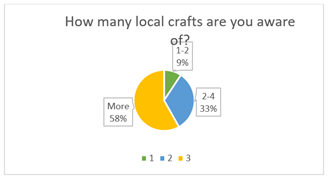
8)
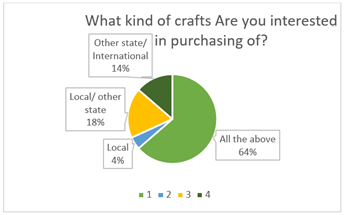
9)
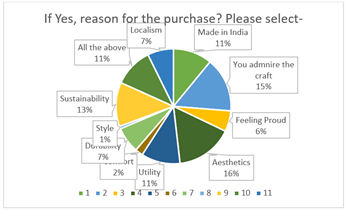
10)
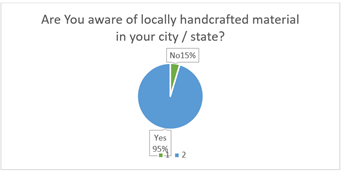
11)
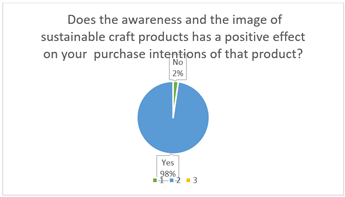
12)
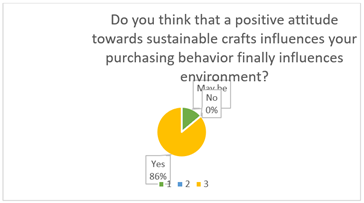
13) All agreed that a garment/ accessory/ product may have an emotional value.
14)
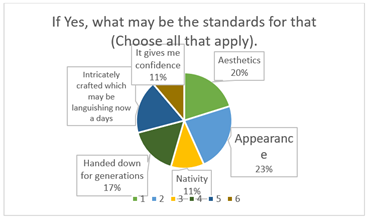
15)
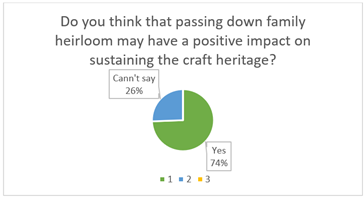
16)
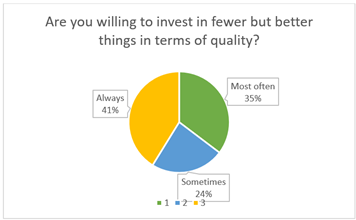
17)
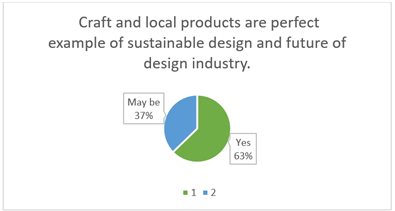
18)

19) 63% of customers would like to suggest changes and customize the product if given a chance, whereas 37% do not want to participate in customization but are not satisfied with the product.
20)
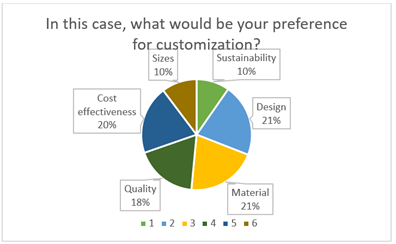
21) 23% of people think all crafts are sustainable, while 77% believe they may or may not be.
22) If not, would awareness need to be created among
society? 09% of people think that the consumer will decide by themselves. At
the same time, 91% believe that awareness needs to be created.
23) Suggestions as received from primary research-
If the traditional crafts are incorporated with a modern color scheme or design more people will buy the craft as it will match with a modern aesthetic. Handcrafted products are not always but most of the times sustainable and good quality, but their cost is higher than usual products that's why I choose cost-effectiveness sometimes people opt for minimal design and also durability. the cost of such products is higher, which sometimes makes it difficult to purchase at all times The same design and techniques can be worked upon on some other than-usual materials I love craft products; with excellent craftsmanship comes excellent confidence. It should be aesthetically appealing and should also be durable and budget-friendly Most handcrafted products are higher in price, which demotivates common people from buying them It should be user-centric; this is not applicable but can be applied to make the craft more valuable. Preference materials that can be recycled in the country the product is intended for the biggest reason for hesitation in buying handcrafted products regularly is the price point, so my preference would be to lower the cost price a tad bit Integration of certain levels of technology without disturbing the original essence of the craft. I want to suggest some changes according to my requirements. Need quality assurance, especially in the material used Ethnic value and heritage addition craft or trade is a pastime or an occupation that requires particular skills and knowledge of skilled work Handcrafted products need design and trend input to make them attractive for all.
|
|
 This work is licensed under a: Creative Commons Attribution 4.0 International License
This work is licensed under a: Creative Commons Attribution 4.0 International License
© ShodhKosh 2024. All Rights Reserved.


